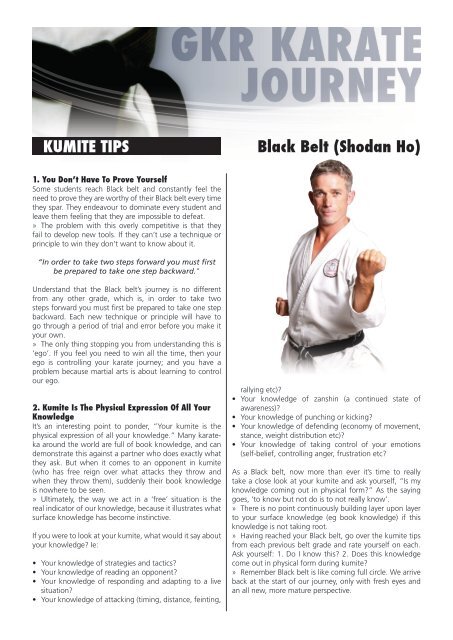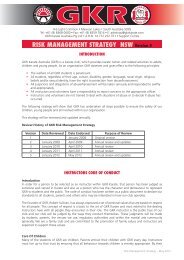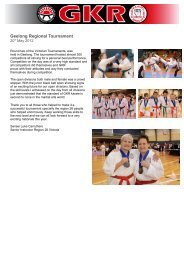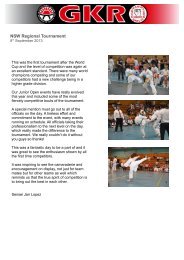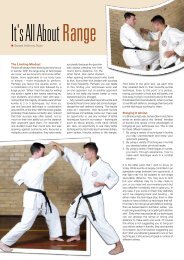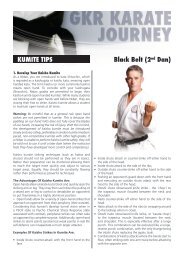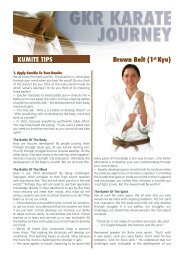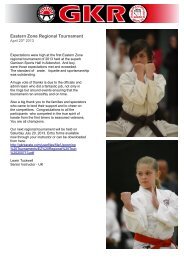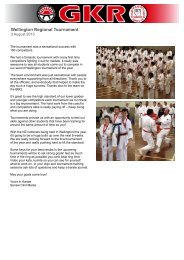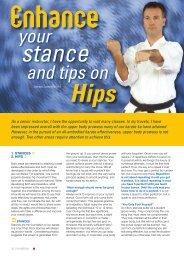Black Shodan Ho Fact.. - GKR Karate
Black Shodan Ho Fact.. - GKR Karate
Black Shodan Ho Fact.. - GKR Karate
- No tags were found...
You also want an ePaper? Increase the reach of your titles
YUMPU automatically turns print PDFs into web optimized ePapers that Google loves.
Kumite Tips<strong>Black</strong> Belt (<strong>Shodan</strong> <strong>Ho</strong>)1. You Don’t Have To Prove YourselfSome students reach <strong>Black</strong> belt and constantly feel theneed to prove they are worthy of their <strong>Black</strong> belt every timethey spar. They endeavour to dominate every student andleave them feeling that they are impossible to defeat.» The problem with this overly competitive is that theyfail to develop new tools. If they can’t use a technique orprinciple to win they don’t want to know about it.“In order to take two steps forward you must firstbe prepared to take one step backward.”Understand that the <strong>Black</strong> belt’s journey is no differentfrom any other grade, which is, in order to take twosteps forward you must first be prepared to take one stepbackward. Each new technique or principle will have togo through a period of trial and error before you make ityour own.» The only thing stopping you from understanding this is‘ego’. If you feel you need to win all the time, then yourego is controlling your karate journey; and you have aproblem because martial arts is about learning to controlour ego.2. Kumite Is The Physical Expression Of All YourKnowledgeIt’s an interesting point to ponder, “Your kumite is thephysical expression of all your knowledge.” Many karatekaaround the world are full of book knowledge, and candemonstrate this against a partner who does exactly whatthey ask. But when it comes to an opponent in kumite(who has free reign over what attacks they throw andwhen they throw them), suddenly their book knowledgeis nowhere to be seen.» Ultimately, the way we act in a ‘free’ situation is thereal indicator of our knowledge, because it illustrates whatsurface knowledge has become instinctive.If you were to look at your kumite, what would it say aboutyour knowledge? Ie:• Your knowledge of strategies and tactics?• Your knowledge of reading an opponent?• Your knowledge of responding and adapting to a livesituation?• Your knowledge of attacking (timing, distance, feinting,rallying etc)?• Your knowledge of zanshin (a continued state ofawareness)?• Your knowledge of punching or kicking?• Your knowledge of defending (economy of movement,stance, weight distribution etc)?• Your knowledge of taking control of your emotions(self-belief, controlling anger, frustration etc?As a <strong>Black</strong> belt, now more than ever it’s time to reallytake a close look at your kumite and ask yourself, “Is myknowledge coming out in physical form?” As the sayinggoes, ‘to know but not do is to not really know’.» There is no point continuously building layer upon layerto your surface knowledge (eg book knowledge) if thisknowledge is not taking root.» Having reached your <strong>Black</strong> belt, go over the kumite tipsfrom each previous belt grade and rate yourself on each.Ask yourself: 1. Do I know this? 2. Does this knowledgecome out in physical form during kumite?» Remember <strong>Black</strong> belt is like coming full circle. We arriveback at the start of our journey, only with fresh eyes andan all new, more mature perspective.
Keys to making Sanseru’s Iron Shirt senjutsu work:Very often bunkai appears very different to the actualkata technique. In this case, the technique is performedclose to identical to the kata, only the timing changesdramatically.StanceQuickly take your Sanchin dachi, ensuring your posture isstraight. As with the kata, ensure your core is at full tension.This tension serves to protect your body from a blow (IronShirt) and helps to keep your body from collapsing out ofstance should you receive a blow.» Be sure that when you step forward your feet still movein an arc, coming closer together before going back out toone shoulder width.» Keep the hips square to your opponent at all times. Thestance will keep the groin protected, the tension will protectthe body and the hands (to be discussed) will endeavour toensure we do not receive a strike.» The main difference is the speed at which we move instance. Where the kata has us take slow steps with a pausebetween each, in combat, move through very quickly instance without any stopping whatsoever. The key is todevelop momentum in the short steps of the stance.» The final key is to keep marching forwards. Don’t stopwhen they throw their attack (else it will develop fullmomentum and push us out of stance if it scores). Bymarching right over the top of them it puts them on theback foot, taking away their power.GuardOnce again, do it exactly like the kata. Quickly create yourmorote uchi uke (double inside hooking block) and marchforward holding this position until your opponent actuallystrikes.» We opt for the morote uchi uke guard instead of ourregular fighting stance guard for two reasons:» Firstly, the position is quite protective. The elbowsprotect our floating ribs and our forearms or hands canquickly move to block an incoming strike without havingto move more than a few inches.» Secondly, it sets an ambush. The position of the armsencourages your opponent to strike down the middle (thearea that is open). Yes we are actually, purposely, exposingour vulnerable centre line. It might seem ludicrous butremember, we are in control this time. By marching forwardsquickly, our opponent will have to retreat or strike onceyou step inside their distance. Therefore, the moment theyeven begin to strike you can quickly cover and defend.» Remember the ultimate goal is to march right overthe top of the opponent. You keep marching forwards insanchin dachi. At some point your opponent will strike.When this occurs you have to block and counter as quicklyas possible. The fact that you are moving forwards waitingto block means you are in control of when they strike soyou will be ready for it.4. Catch A Tiger With A NetWe have already discussed how a <strong>Black</strong> belt’s goal is to gofull circle; to revisit or re-read over every principle learned,every habit acquired and see it with fresh eyes. With fresheyes comes a deeper understanding and perspective, likepeeling another layer off an onion and getting closer tothe core.» One such principle and habit to revisit is the idea ofsoftness. As a lower grade, a common error you likelymade when practicing basics was you were too tense. Acommon error you likely made when practicing kata wasyou were too tense. And a common error you likely madewhen sparring was, you guessed it… you were too tense.» But over time you developed an understanding of theconcept of ‘relax, tense, relax’. In other words, to startrelaxed and only tense up at the end of a technique. Andfinally, immediately afterwards, relaxing once more.» The question is, have you really softened up? The likelyanswer is ‘there is much room for more’.» This is because people associate karate with strength andthey subconsciously associate strength with stiffness. Butreal strength comes from softness and real-defence (suchas blocking) comes from softness. Think about it, does ahunter walking through the jungle on their quest to catcha tiger drag a six-foot steel cage (something stiff) withthem? Or do they carry a net (something soft)? The answeris they catch a tiger with a net! The net has been used asa weapon for thousands of years. Even in the Colosseumin Rome, gladiators used a net to get the advantage overtheir enemy.» When practicing your blocks kumite, aim to relaxyourself more than you ever have in the past. Don’t justfeel the relaxation in your arms, allow it to extend to therest of your body (but do not achieve this via standingup higher in stance). When you choose to attack it willactually add more speed and weight to your strikes. Andwhen defending, you will be able to move more freely andwith more weight in your arms.» Completely relaxing your wrists may also find that youstart to block with your forearm and immediately afterblocking, seize your opponent’s striking arm with your fist.This will allow you to seize, control and destabilise youropponent.» Finally, relaxing your body will allow your mind to relax.When the body is tense the mind follows suit and is unableto think on the go. Relaxing the body will allow the mindand body to work fluently in synch with little or not thoughtat all.5. Elegance, Not Elephants!The previous point involved revisiting your relaxed blocking.This point asks you to look more closely at your footworkand movement. Beyond being relaxed, fluency counts.While you likely have a good grasp of numerous kumitemovements (attacking combinations etc), you must askyourself, “Am I moving with fluency?”» This principle equally applies to kihon, kata and kumite.An individual technique practised flawlessly is bar one partof the equation; we must also seek to move flawlessly
etween those techniques.» Having reached <strong>Black</strong> belt, maintain your focus ondeveloping yourself rather than just winning in the dojo.Winning is great but you want to look like someone whohas mastered their body in the process.» Your goal when moving in your karate is to be silent.You should move fast but equally, swiftly, lightly, quietly.As a master once said to a class, “I want elegance, notelephants!”6. Avoid Sport KumiteIf you go back and read the Yellow Belt Kumite tips youwill find we discussed that kumite is about developing selfdefencehabits, not sporting ones.» Reiterating this point at <strong>Black</strong> belt is by no meansmeant to be condescending. Ultimately it really comesback to things going full circle once more. You will notean underlying theme of going full-circle throughout your<strong>Shodan</strong>-ho journey; and for good reason.» Having achieved your <strong>Black</strong> belt you have spent hoursupon hours in the dojo sparring. And while this importantfor self-defence, over time it is also easy to develop certainhabits - after all human beings are creatures of habit! Themore we spar the more we direct our focus on becomingbetter at sparring. And this does not always translate tobetter kumite.» When we use the term ‘Avoid Sport Kumite’ we arenot referring to tournaments, we are referring to sparringwhere you create habits that ‘play within the rules’. Asport is any game that is dictated by a set of rules playersabide by. Therefore, any type of kumite; be it dojo sparring,tournament sparring, full-contact karate, even cagefighting is a sport.» The key is that while we must abide by the rules, ourhabits should be dictated by what could happen. Forexample, our opponent is not permitted to tackle us to theground like a footballer. As such we may stand up in ourstance. Should we find ourselves in a real life confrontationhowever, the habit to stand up in stance will likely find usbeing tackled to the ground.» So it’s time to review your favourite techniques (forboth attack and defence) and ask yourself, “Are myhabits following effective self-defence principles or am Icompromising these in the interest of sport?”7. Develop Your Ashi Barai (Foot Sweeps)At <strong>Black</strong> belt level (<strong>Shodan</strong>-ho) you are introduced to thefoot sweep (ashi barai).The ashi barai has the ability to the following:• Put your opponent on the ground.• Leave your opponent completely unbalanced.• Leave your opponent slightly off balance yet toodistracted to protect themselves from a forth comingdevastating attack.In either of the above circumstances, it leaves the personwho executed the sweep with a massive advantage, andfor real life combat, in a position to end the confrontationquickly.» While it has many perks – one of which being animpressive technique – it also comes with many risks if youaren’t well versed in what you are doing. Therefore, beforeyou begin practising foot sweeps in kumite, you should bewell aware of what you are doing.Key Aspects To Developing An Effective Ashi Barai(Foot Sweep)The three most common errors people make when tryingto sweep are:i) Looking down at the opponent’s feet: This telegraphsyour intentions so your opponent can easily avoid it.What’s more, by looking down, you won’t see thepunch they have in store for you.ii) Moving forward into your opponent’s personalspace: When you move forward into your opponent’spersonal space, their natural reaction will be to eitherstep back (causing your sweep to miss) or to put theirweight back onto their rear leg. When their weightis on their back leg, sweeping their front leg willnot have the desired result, as they will be able tomaintain their balance.iii) Failing to use the body. If you are sparring someonehalf your weight you don’t need to use your body.But how often will someone half your weight attackyou in real life? Many karate-ka attempt to sweepusing only their leg. Not only is this ineffective, it canleave the ‘sweeper’ unbalanced.The following are two basic foot sweeps:1. Defensive Sweep: The Inside Front Foot SweepWhen most people attempt to score with a hand techniqueduring kumite, to gain correct distance for their strike, theyslide their front foot forward just before executing theirstrike. This not only brings them close enough to strike, itbrings their weight forward, adding more power to theirtechnique.» During the small amount of time their front foot ismoving, they are completely vulnerable to a sweep.» For the practised karate-ka, this is an opportune time toattempt a sweep. To find success with this technique, studythe following:a) Be sure to block. Don’t be so focused on the sweepthat you forget to defend the technique your opponenthas attacked with. During the process of your sweep,still commit to blocking.b) Don’t lift your foot too high. The time to start yoursweep is the moment they lunge out with their frontfoot. You will likely make contact just before they landtheir front foot. Don’t lift your foot up off the ground,allow is to slide along the ground (like when movingthrough in stances).c) Make contact at the correct point. As you move yourfront foot across to meet their moving front foot, be
sure the inside arch of your foot meets the just abovetheir inside heel.d) Bring your weight back. If you try to sweep solelyusing your leg muscles, you will unlikely be strongenough (unless your timing is perfect). Be sure to moveyour weight back onto your back leg at the same timeyou sweep.e) Practise against an imaginary opponent. Sweepingis difficult to learn with a real opponent. Practise yoursweeps during shadow sparring. This is where you willfine-tune your technique, weight distribution and speed.Once you have this down pat, practicing on opponentswill develop your timing.f) Do not attempt a sweep on any student below<strong>Black</strong> belt. It is common sense that you would notsweep a lower grade student who does not have theability to handle the technique, nor has been trained todefend against a sweep.2. Attacking Sweep: The Rear To Front Outside FootSweepHave you ever felt nervous to attack an opponent becauseevery time you move forward they remained in their strongstance and threw a strong punch your way?No matter what you try, they just stand there and punchyou?» Two techniques are highly effective in dealing with thesetypes of fighters. Firstly, the side kick (as it has more reachthan their pick off punch and is a strong technique), andsecondly, the rear to front outside foot sweep.» This basically means your rear leg moves through andsweeps the outside of your opponent’s front foot.» To find success with this technique, be sure to study thefollowing.a) Be prepared to get hit. Just because you’re movingthrough with a sweep doesn’t mean they won’t stick totheir guns and throw a punch the moment you entertheir range. Don’t be so focused on the sweep that youforget to defend their pick off as you sweep. Come inshielding yourself and preparing to block. And don’t behesitant in sweeping just because they might punch, asif you are hesitant you will surely fail.b) Distract them first. Distract their focus by movingthrough with a fake reverse punch. This not only distractstheir eyes (hiding your sweeping foot) it can deter themfrom picking off, or at least deter them from movingtheir weight forward as they pick off.c) Make contact at the correct point. A common erroris to bring the back foot through and make contact withthe opponent’s upper shin. As you move through, keepyour foot sliding just above the ground (just like whenmoving through in stances). Be sure the inside of yourarch hits just above your opponent’s outside heel.d) Use your hips. If you try to sweep solely using your legmuscles, you will not be strong enough. Be sure that asyou swing your foot around to sweep that you also useyour hips. Your hips should swing into gear just as yourfoot is about to make contact with their foot.e) Keep your eyes forward. Don’t look down or you willgive your intention away. Use your peripheral vision toknow where their foot is. You can practise on trees, asoccer ball, a partner in slow motion, anything!f) Don’t move into your opponent’s personal space.When you move forward into your opponent’s personalspace, their natural reaction will be to either step back(causing your sweep to miss) or to put their weight backonto their rear leg. When their weight is on their backleg, sweeping their front leg will not have the desiredresult, as they will be able to maintain their balance. Asyou move forward, stay just outside their arm’s reach –your leg should be able to reach.g) Speed counts. If you are too slow, or offer a poordistraction, your opponent will see it coming andeither move away or lift their front leg up so you misscompletely. You need to practise often so that youdevelop speed. Stay low throughout as raising up yourheight will slow you down.h) Be prepared to miss. It’s common to miss completelywhen attempting this sweep, especially if you are knownfor it. It’s important to maintain zanshin (a continuedstate of awareness) otherwise you might find yourself ina vulnerable position after missing.i) Practise against an imaginary opponent. Sweepingis difficult to learn with a real opponent. Practise yoursweeps during shadow sparring often. This is whereyou will fine-tune your technique, weight distributionand speed. Once you have this down pat, practicing onopponents will develop your timing.7. Follow Up Sweeps With KicksWhen we first start sweeping, we generally follow upwith a hand strike. As you develop your sweeps, it can bean exciting challenge to follow these up with a kick. Bemindful your kicks are more powerful than your punchesand can end a self-defence situation quickly. Not only this,following sweeps up with kicks displays advanced levels ofcoordination and distance.» Use your back leg to hook in behind and sweep theoutside ankle of your opponent’s front foot. Done properlyand your opponent with either:• Fall to the ground.• Be unbalanced for a brief time.• Be turned around (exposing their side or back).• Shift their weight onto their back leg in retreat.Regardless of the outcome, quickly follow up your sweepby executing a kick off the opposite leg. A Round Kick ishighly effective; as the motion of sweeping will see yourhips turn towards your back leg. This puts them in primeposition to swing back towards the opponent with a fastand powerful round kick.» When an opponent is taken off balance, in an attemptto re-stabilise, human nature dictates that they thrust botharms out to the side (like a tight-rope walker). This willopen their kidneys and floating ribs right up, making around kick a highly effective.


